Manley Studio Reference Series 240/100 Watt Monoblock Tube Power Amplifier USA
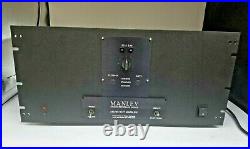
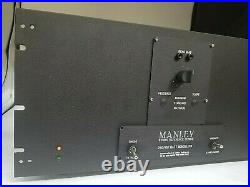
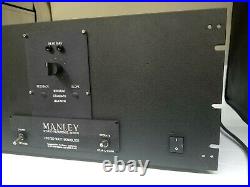

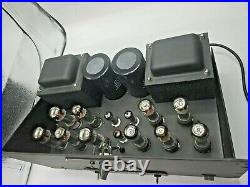
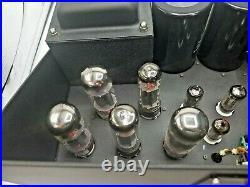
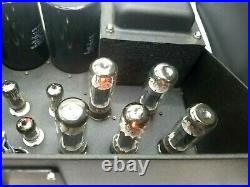
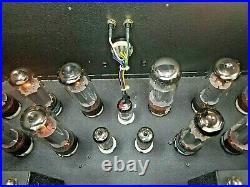
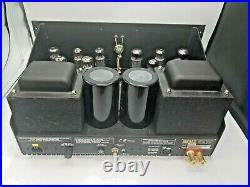
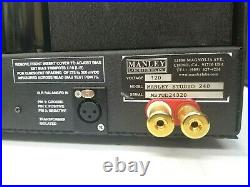
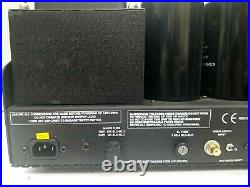
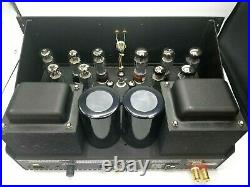

USED MANLEY STUDIO REFERENCE SERIES 240/100 WATT MONOBLOCK TUBE POWER AMPLIFIER. Recently obtained from a professional recording studio that had closed up. In excellent condition, very clean all around. Tested and working, pulled from working environment. Amplifier has 10 EL34 power tubes.
I believe 7 or them are Russian made Tungsol and 3 of them have been replaced with Ruby Tube EL34. See photos for a good idea of the overall condition. Note: This is a mono power amplifier, not a stereo amp! Listing is for (1) Manley 240/100 Watt monoblock amp with AC power cable only, as pictured.
GRAB IT WHILE IT LASTS! Below is a review of the amp I found online, and specs. I do believe all specs given in the review are correct for this amplifier.
The Manley Reference 240 is the little brother of the Manley Labs Reference 440 monoblock. While it is not the sort of contraption you'll find in the home of your average grade-school teacher, the Reference 240 might appeal to an audiophile with a penchant for tubes and some sense of fiscal propriety. I'm not a tube-swapping kind of guy (I've learned that fooling around with hot tubes can burn ya), or even a tubeophile (life is too short to spend half my waking hours curled around a hot component trying to achieve optimum output-tube bias). I prefer to spend my reviewing hours judging a component's neutrality, transparency, and fidelity rather than its ability to make me wax lyrical over Frank Sinatra. However, my time with the Manley 240s reaffirmed my faith that some tube amplifiers are for manly men. There are a lot of tube amplifiers on the market, but David Manley's designs are unique in several exceedingly important ways.Manley Labs makes all of its audio transformers in-house, employing several proprietary design techniques, including twin-coil output transformers. In a twin-coil transformer, each leg of the push-pull topology is identical because it involves an identical number of turns in the transformer, guaranteeing that DC resistance is the same for each leg. Moreover, since there is a separate and physically identical coil for each phase half, everything elseleakage inductance, primary inductance, DC resistance, impedance, and stray capacitancewill also be identical. This transformer design, coupled with Manley's use of a double driver tube for each phase of the push-pull circuit, makes the Reference 240 a true differential push-pull amplifier.
David Manley is adamant that the only proper way to make a push-pull design is with a fully balanced differential circuit. Many of the problems with crossover distortion that are blamed on push-pull designs are a result of improperly balanced legs, he feels. Think of a chair with one support 2 shorter than the other and you'll get the idea. Manley designs may be among the only tube amps on the market that fulfill the potential of the push-pull design philosophy.
While the Reference 240 has both balanced XLR and single-ended RCA inputs, it is not a fully balanced differential design from input to output. The XLR input signal goes to a Manley-built transformer, which converts it into a conventional single-ended signal to be fed to the amplifier's input stage. The single-ended RCA input goes directly to this same input stage, which consists of a 12AT7 twin-triode tube, with its halves in parallel. This input tube's output is sent to the splitter stage, which consists of one double-driver, a 6414 tube. Each half of the push-pull circuit uses a separate 6414, the outputs of which drive the EL34 output tubes.
There is nothing radical about the circuit topology. The goal is to take a tried-and-true design and execute it as well as is humanly possible. The Russian-made EL34 Tubes used in the Manley 240 are matched using a proprietary computer program. In theory, since each output tube has its own individual bias adjustment, matching should not be necessary, but Manley has found that far better performance can be achieved if the tubes are critically matched.
My experience with the Reference 240 has shown the output tubes to be phenomenally stable. I checked the bias several times during the two months that I had the amplifiers in-house, and I never had to make more than minuscule adjustments to any bias setting. This remarkable stability may be disappointing to those tweaks who live to check tube bias.
They could use the time saved to listen to music. The Manley 240 has four separate power supplies, one for the AC heaters, one for the B+ voltage rail, one for the screen grids, and one for the bias circuit. The very stiff, 600V B+ supply has a capacity of 2600µF.
The power transformer has four primaries so that the Manley 240 can have a "Soft-Start/Ever-Warm" idling capability. In this mode, only 5% of the voltage and 5% of the current are fed to the amplifier circuits. This is quite different from most "standby" switch positions, which merely remove or reduce the B+ rail, something that can actually shorten tube life. The Soft-Start setting on the Manley 240 extends tube and component life by allowing current and voltage to pass constantly through all components so they are never fully turned off. The Soft-Start setting also protects the amplifier against brownouts.Unlike most tube amps, whose owners often leave them on permanently to insure optimum performance, the Manley 240 can be left in Soft-Start mode. Then, if your local power company decides to brownout (suddenly dropping the voltage), the subsequent surge should do no damage. In an amplifier with a regular standby mode, such surges may damage components, since all but the B+ rail is still fully powered. The Manley's Soft-Start setting is not the same as a mute.
Not only will music still play through the Reference 240 while it is in Soft-Start mode, but any connecting or disconnecting interconnects will be audible. Be forewarned you should treat a Manley 240 in Soft-Start mode as you would any other amplifier when it's turned on! Don't pull plugs, disconnect speaker wires, or muck around with any connections on the Manley unless you turn it off.
Your speakers and amplifier will thank you for your consideration. As with most other Manley tube amplifiers, you have your choice of triode or tetrode operation. In triode mode, you've got 100 watts to play with, while in tetrode mode there's 240 watts to whack around. It's like having two amps in one. It's great entertainment for tweaks: a switch that changes the sound of the amplifier.
Just remember to turn off the amp when switching back and forth between modes, or else your new toy might well go poof. You'll never hear those awful words Have you called your local retailer?
We don't deal with consumers! No, you can't keep it for two years, then return it on a whimManley is not a free equipment-rental servicebut they will give you a week or two to thoroughly audition the product. Fit-and-finish on the Manley Reference 240 is generally good, but not exceptional. This amplifier is certainly not as elegant looking as a Rowland Model 6, nor is its internal finish as anal-compulsive as that of a Cello or Mark Levinson product. The Manley has a no-nonsense, workmanlike physical style that says, Hey man, this is an amplifier, not a piece of bloody audio jewelry. Perhaps the interior finish is not suitable for hours of transfixed Zen meditation, but most owners will probably never have any reason to open up a 240 except out of morbid curiosity, or to clean out cat hair. My cats find Manley 240s in "soft-start" mode to be the perfect temperature for long napsflip on full power and yeoooow! Triode vs tetrode: how do you want it, rare or well-done? As anyone with at least 25% of their hearing left can tell you, triode- and tetrode-mode tube amplifiers sound different. Since the Manley Reference 240 allows us to switch back and forth ad nauseam while everything but the operating mode remains constant, it provides a wonderful opportunity to hear the sonic differences between these two modes in a controlled test situation. It is not a simple question of which mode sounds "better, " since "better" is a subjective term that reveals little about how each actually sounds.Each mode has particular strengths and weaknesses. With different sources in different situations, each has appropriate applications. The triode mode excelled at creating a three-dimensional soundstage that breathed life and form into music.
On Music in 18th Century France (Nonesuch H-71371, LP), Ann Monoyio's voice had a palpable quality that was both startlingly realistic and devilishly seductive. The harpsichord and viola da gamba continuo also had a dimensional verisimilitude that sounded both right and voluptuous. Rear-wall reflections were quite convincingly rendered. Triode mode was harmonically lush, with a warm, wet midrange that bounded up to you like an overly friendly Great Dane wanting to get all up close and personal without the benefit of a proper introduction. On intimate and minimalist music, this harmonic approach worked beautifully.
Dense, thickly mixed material, however, could get a bit gummed-up in all the schmaltz. In triode mode, the Manley's presentation of low-level detail was excellent during quiet, simple passages, but became obscured when the music got complicated and cacophonous. Triode mode reminded me of my beloved old Quad ESL speakers, which sounded superb as long as the music suited their particular strengths. Tetrode mode made up in power and control what it lacked in subtlety and dimensional nuance.
On dynamic material like Tori Amos's "Pretty Good Year, " from her Under the Pink LP East-West/Warner Bros. , tetrode delivered the goods without losing its cool. True, tetrode did not do the 3D thing as convincingly, but it did produce a wider soundstage, with more precise lateral imaging to compensate for the reduction in dimensionality.
Tetrode also had a hair better low-frequency dynamics and control than did triode. When the bass tracks on Joan Osborne's "Spider Web" kicked in, tetrode didn't muddy up or lose dynamic articulation.The midrange in tetrode mode sounded less seductive, but it did retain the same amount of inner detail regardless of the music's complexity. Tetrode's midrange was not the warm fuzzy puppy of triode, but was more revealing of the true nature and harmonic fabric of the source material.
When listening for pleasure, I usually select the triode switch on the Reference 240s. Combined with a warm fire, a glass of brandy, and my beloved, the Manleys in triode mode can instill a sense of well-being and cosmic contentment that banishes even the most exasperating daily frustrations. If, on the other hand, I need to know what is really going on in a mix, or I'm wearing my reviewer's cap (the one with the big Mickey Mouse ears), I flip the Manleys into tetrode mode. For full orchestral recordings and "serious" rock and roll at "realistic" levels, tetrode is obviously the way to go. With acoustic folk and small-group jazz, triode provides the intimate warmth needed to make the music glow. The nice thing about the Manley Reference 240 is you don't have to choose either/or... Consider the Reference 240's two amplifiers sharing the same chassis. Perfect for the schizophrenic music lover. I have a pair of Rowland Model 6 solid-state monoblock amplifiers on hand for a forthcoming review. Comparing the Manleys with this radically different but equally excellent design proved both ear-opening and mind-bending. It precipitated a sonic epiphany of sorts (footnote 2). Got that evaluating the differences between great tube and solid-state designs is not as simple as comparing apples and oranges, but as complicated as examining exactly what it is about the music itself that makes us crave it deep within our souls. The Manley Reference 240 is bettered by the Rowland 6 in every sonic parameter save one, but the Manley's superiority in this particular area is so striking, so completely earth-shattering, that all other areas of comparison become moot. What does the Manley do that utterly eludes the otherwise superb Rowlands?Simple: The Manley preserves the soul and emotion of the original performance in a way that escapes the solid-state amplifier. But wait, before you blow this off as cognac-inspired gobbledygook, let me explain. After several days of A/B-ing the Manleys and Rowlands, I began to notice that my reactions to the same music through these two designs was fundamentally different.
When I listened to a live version of Dave Alvin's "Haley's Comet" on DAT with the solid-state amps, I was swept up by the phenomenal performance, the articulation of each individual musical part, and the interactions of these parts. I was both intellectually stimulated and challenged by the wealth of musical information available. When I listened to that same cut through the triode-mode tube amps, I cried. Yup, tears rolling down my cheeks while I bounced up and down, waving my arms, physically buffeted by the raw emotion of the music.
Emotionthat essential component at the very core of great music. The Manleys pass through that emotional information, but the Rowlands don't. Time after time, I examined how the music was affecting me. It was always the same: through the Rowlands I was intellectually stimulated; through the Manleys I was moved.
The Rowlands are cerebral, but the Manleys are emotional. This all begs the question, Why do we listen to music?For some, the emotional connection is all-important, while for others, the genius of creation is the spark that drives them into their listening rooms. Before this, I never "got" the single-ended triode thing.
Funky little single-ended triode amps are musically colored, little electronic Tinkertoys, as incapable of producing sonic neutrality as a cockroach is of singing the "Star-Spangled Banner" (Roseanne aside). If, as claimed by the effervescent Harvey Rosenbergsingle-ended evangelist-extraordinairemusical enjoyment is all about experiencing ecstasy, then tube gear brings the listener the raw emotion of the music.Even if it is more severely colored than a piece of paper fresh from a five-year-old with an ultra-deluxe box of crayons, tube gear is the only way to really hear the voice of God. For a guy like me, for whom neutrality and transparency have always been the goals of high-end audio, this is mind-bending. Listening to live music, this dichotomy between emotionality and intellectuality doesn't exist.
The finest recordings of this same piece of music don't pack the same combination of intellectual and emotional power. Because no matter what the quality of the sound system, something is lost. Defining just what that something is represents the Holy Grail of the High End. Do I have the answer?No, I'm just another poor beggar who understands that the problem exists. Perhaps having both the superb articulation of the Rowlands and the emotional accuracy of the Manleys would be too much for our puny biological systems to tolerate.
Smoking husks of our earthly remains would litter our listening chairs if one amplifier could do it all. But still, when I'm listening "professionally, " trying to hear differences and variations from neutrality on source material, the Rowland Model 6 is a far more useful tool than the Manley Reference 240. But when it's late at night and I need a musical fix to make me forget all the crud swirling around in my brain, a pair of Manley 240s is just what the doctor ordered. This dichotomy between tubes and solid-state is what keeps sending audiophiles scurrying back and forth between them. There isn't a simple solution, only the expensive option of owning both tube and solid-state amplifiers.
I hear evil laughs emanating from high-end dealers everywhere. We all seek that one component without flaws, that does everything so impeccably that we can clearly and effortlessly identify the voice of God through our sound systems. The Manley 240 is not the last, most-perfect amplifier you will ever want, but it is damn good. It excels at transmitting the raw emotion and energy of live music. In triode mode, a pair of Manleys produces a remarkably three-dimensional soundfield that is both convincing and seductive. When switched into tetrode mode, the Manleys have the brawn to deliver a full symphony orchestra directly into your living room. Unlike many tube amplifiers that have let their smoke out in my listening rooms over the years, the Manley Reference 240s were exceptionally reliable during their three-month visit.Not only was biasing a simple painless process, but monthly checks revealed that the Manleys hold their bias beautifully. This may just be the tube amplifier for folks who love the way tube amps sound, but hate the way tube amps work; or don't work, as the case may be. While it may not be as simple as trundling off to your local hi-fi emporium if you wish to hear a pair of Manley 240s, if you are searching for an amplifier to light your soul on fire while keeping your house flame-free, the Manley 240 may be just the thing to satisfy your cravings. Manley Studio Chassis 240 Watt and 440 Watt Monoblocks. 10 x EL34/6CA7 output tubes.
High current double 6414 driver stage. 12AT7WA dual triode input tube.
SOFT-START / EVER-WARM standby mode. MANLEY Precision output transformer Factory set for 5 Ohm nominal.
Front panel bias measurement and adjust. Input sensitivity adjustable 0 to +4dB. FLAT frequency response 10Hz - 30KHz continuous power. Minimum (idle) power consumption: 400W. Maximum (at rated full power output) power consumption: 1400W.Factory set for 100V, 120V or 220-240VAC operation for original destination country's mains voltage. Operating Mains Voltage changeable with power transformer re-wiring and fuse value change. Dims: 19" X 8 3/4" X 11. Please do not open any cases or claims without contacting us first.
We will be able to resolve any problems directly and make sure that any issues are taken care of immediately. Our near perfect feedback speaks for itself. THANK YOU FOR YOUR BUSINESS. The item "Manley Studio Reference Series 240/100 Watt Monoblock Tube Power Amplifier USA" is in sale since Friday, October 23, 2020. This item is in the category "Consumer Electronics\TV, Video & Home Audio\Home Audio\Receivers & Amplifiers\Amplifiers & Preamps".
The seller is "newyorkmusicmall" and is located in Brooklyn, New York. This item can be shipped to United States.
- Number of Channels: 1
- Audio Outputs: Banana Speaker Jacks
- Model: Manley Studio 240 / 100
- Country/Region of Manufacture: United States
- Audio Inputs: RCA
- Type: Monoblock Tube Amplifier
- Features: Analog
- Number of Outputs: 1
- MPN: 240/100 Monoblock
- Number of Inputs: 1
- Brand: Manley
